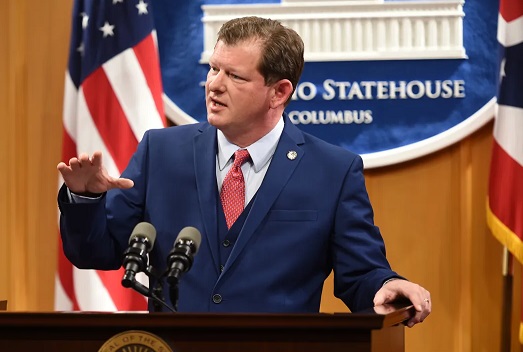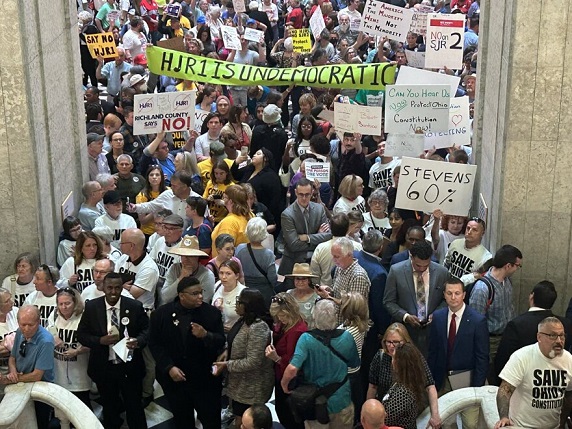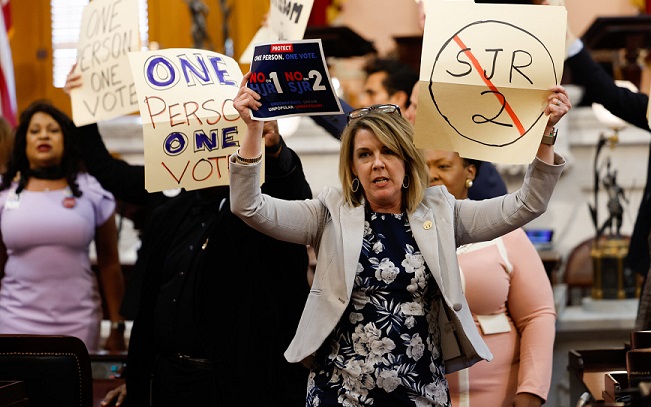Ohio House Votes To Send 60% Approval Amendment To Special Election In August!
FEATURED PHOTO: SENATE PRESIDENT MATT HUFFMAN R-DISTRICT 12

IdeastreamPublicMedia.org, By Jo Ingles & Karen Kasler-STATEHOUSE NEWS BUREAU, Posted May 15th 2023
Ohio lawmakers beat a Wednesday deadline to pass a resolution (SJR2) that could put before voters in an August special election a decision on whether to make it harder to amend the constitution. Wednesday evening, after two new House members were appointed to open seats, 62 Republican members of the Ohio House voted to approve the resolution. But that didn’t happen without a lot of controversy.
It’s possible the resolution could still face a legal challenge because it contains language about scheduling a special election. Steven Steinglass, dean emeritus of the Cleveland State University College of Law, said the resolution itself contains a vehicle to create an election. He says those are “two distinct legal instruments that cannot be combined.” But Ohio Senate President Matt Huffman (R-Lima) said legal counsel for the legislature told lawmakers the resolution is legal. And House Speaker Jason Stephens agreed.
“Our legal team has put together and looked at the resolution and feels like it is a solid resolution that should be able to withstand any legal challenge,” Stephens said.
Jen Miller with the League of Women Voters of Ohio said her group is considering a lawsuit over the matter.
“We are looking at that because it is absolutely illegal to call for an August election in a resolution,” Miller said.

Lawmakers in the House went down to the wire in the effort to put the measure before voters. This resolution raises the passage threshold to 60% instead of the current requirement of 50% plus one. It also requires petition signatures from all 88 counties. Right now, petitioners only have to collect in 44 counties. And this resolution eliminated what is known as the “cure period” when more signatures can be collected and added to the total after petitions are initially submitted. May 10 was the last date to pass the resolution to be able to put it on the August 8 ballot.
The resolution is controversial
More than 250 unions and community groups have come out in opposition to it. Hundreds of the opponents packed inside the rotunda of the Ohio Statehouse while the vote was being taken. They chanted so loudly that they could be heard inside the chamber, even with its heavy doors closed, as the resolution was debated and the vote was taken.
Ohio House Minority Leader Allison Russo (D-Upper Arlington) told reporters after the vote that she is disappointed with Republican Speaker Jason Stephens (R-Kitts Hill), who was elected to that position with the support of all 32 Democrats.
“The Republican majority has made it very clear that they will cave to extremists, cave to out of state interests, cave to partisan politics,” Russo said.
Ohio Education Association President Scott DiMauro said his union will work to defeat the resolution, just like it did more than a decade ago when lawmakers passed an anti-collective bargaining law. That legislation was later repealed by voters.
“Politicians then kicked a hornets nest and incited a movement across the state,” DiMauro said.
Though greatly outnumbered, some supporters of the proposal came out to make their voices heard too. Many were aligned with groups that oppose abortion. Beth Vanderkooi, executive director of the Greater Columbus Right to Life, said she’s looking forward to selling the constitutional change to voters.
“We need to create additional safeguards for Ohio’s constitution so I think that it will be a great day for Ohio,” Vanderkooi said.

It has taken time for lawmakers to pass the resolution
The effort to pass the resolution was hard fought. It started last November when Secretary of State Frank LaRose first brought forward the plan to increase the voter approval threshold for constitutional amendments, along with fellow Republican Rep. Brian Stewart (R-Ashville). Both claimed it was about protecting Ohio’s founding document from big money and out-of-state special interests. But in a letter to his Republican lawmakers that surfaced in December, Stewart made it clear that the main drivers were defeating abortion and gerrymandering amendments.
At the time, supermajority Republicans weren’t able to get the 60% threshold before voters in the May primary, which had to happen by early February of this year. Then two groups working on a reproductive rights and abortion access amendment teamed up to try to make this November’s ballot. They are currently collecting signatures.
That sparked Republicans to propose creating an August special election for the 60% threshold vote — which was a flip from Republicans’ view from December, when most August elections were eliminated because of high costs and low turnout.
Election Day could be August 8, unless the resolution is stopped by the courts. The head of U-Line, Richard Uihlein, has give roughly $1.1 million to a PAC that’s urging the Ohio House to set an August election for the 60% resolution. Unions and others who oppose the constitutional change said they have a lot of grass roots support and will use those forces to defeat the proposed constitutional change.

